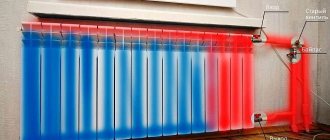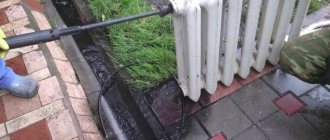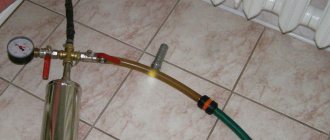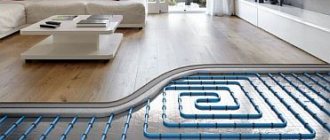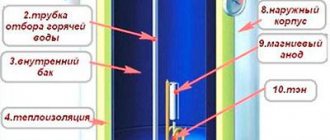Preventive actions
Of course, it is necessary to know how to properly bleed air from a battery.
But it is much better that airing of the system occurs as rarely as possible. To prevent this problem from occurring, you need to install an air vent. Air collectors for heating systems come in two types:
- manual - Mayevsky crane;
- float - automatic.
Each of these devices can be installed in any place where there is a risk of air locking. The Mayevsky crane has a traditional configuration, and the air vents can be angled or straight.
In order not to hastily solve the problem of how to bleed air from the radiator and de-air the heating system, it is necessary to install an air vent on each radiator.
A manual device makes it easy to eliminate an air lock; it is usually placed on the end side of the battery. To do this you need to have a special key at your disposal. The performance of a manual air vent is small and therefore it is used for heating systems operated at home.
Air vents of the second type operate in automatic mode. When using them, there is no need to unscrew or open anything, since the device does everything on its own. It should be installed strictly in a vertical or horizontal position.
But the automatic valve, designed to drain excess air from the heating system, has a drawback - it is highly sensitive to various contaminants. Therefore, its high-quality operation can be ensured by an additionally installed filter that will protect the device from them.
If air has collected in the heat supply structure, you should definitely determine the cause of this problem, especially if such situations have not happened before. The main thing is not only to eliminate the airlock, but also to take all necessary measures to prevent it from appearing again.
Prevention
To avoid problems with air locks, it is necessary to install air vents at each group of heating elements. So, for example, to remove air from the boiler, an automatic valve for removing gases is mounted directly on it. All collectors are also equipped with it. Mayevsky taps are installed on the radiators at the end.
If, after bleeding the air, the radiators still do not heat up well, the coolant should be completely drained. Since it is possible that there is too much dirt in the network, and it significantly reduces the circulation of fluid in the batteries.
How to bleed air from a battery
Usually, the fact that the system is airy is indicated by extraneous sounds, for example, gurgling, hissing, or water flowing. Bleeding air in these cases is simply necessary.
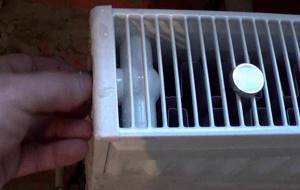
If the suffocation is strong, you first need to mark the places where air accumulates. It is determined by tapping the heating system with a hammer. In a place where there is an air lock, you will hear a louder and stronger sound. The air is usually collected in radiators that are installed on the upper floors.
What to do if the system becomes airy:
- Take a wrench or a screwdriver and prepare a container for water;
- Having opened the thermostat all the way, open the valve of the Mayevsky tap and place the container;
- Keep the valve open until water flows out of it;
- After receiving a clear flow of water from the tap, close it.
It happens that after this procedure, the radiator of the heating system of an apartment building does not heat for long or weakly. Then it needs to be blown out and washed, since the accumulated debris and rust in it causes a blockage and can also cause the formation of air locks. If there is no improvement after this procedure, then you need to check the water level in the heating system. Air pockets constantly form at pipeline bends
In view of this, during the installation process it is important to observe the direction and degree of slope of the distribution pipelines. Where the slope differs from the design, an additional air vent must be installed, from where air can be vented
Air pockets form most intensively in aluminum radiators. This happens mainly due to the poor quality of the material. In order for the heating of the apartment to be normal, it is necessary, before filling the system with water, to promptly release air from it, which interferes with the normal movement of the coolant. That is why many residents of apartment buildings cannot drive the cold out of their apartments.
How to bleed air from different types of batteries
Based on the material of manufacture, space heating devices are divided into a number of types of batteries with their own characteristics of air bleed - these are radiators:
- aluminum;
- steel;
- bimetallic;
- cast iron;
- copper;
Aluminum
Heating devices made of aluminum are made by extrusion of molten metal. That is, liquid aluminum is pressed into the flask. The material of the radiators is quite soft and deforms at the slightest mechanical impact. For this reason, aluminum batteries are recommended to be installed in private houses with autonomous heating systems equipped with automatic air vents.
Steel
Batteries made of steel are very durable. Therefore, they easily tolerate the installation of both Mayevsky cranes and automatic machines. Sometimes both are replaced with thermostats.
Bimetallic
Radiators that have a steel body covered with aluminum alloy fins are most often equipped with Mayevsky taps. Bimetallic devices are installed in private mansions and apartment buildings. Depending on local heating conditions, the radiators are equipped with automatic air discharge devices.
Cast iron
The peculiarities of cast iron, as a brittle material, force one to be careful when choosing devices for releasing air pockets. Basically, as mentioned above, conventional taps or mortise bolt valves are used.
Copper
This expensive, but excellent in its thermal conductivity, metal requires delicate handling. For copper radiators, special devices are used, built on the principle of the Mayevsky tap. The condition for inserting devices made of the same metal as the radiator itself is met - copper.
All these features of installing devices for bleeding air from batteries made of various materials do not depend on their design, whether they are sectional, tubular, panel, plate or vacuum devices.
Heating system without air locks
To ensure that air in an individual heating system does not accumulate in problem areas, but goes outside, it is necessary:
- correctly design and install the pipeline, correctly install radiators;
- use automatic and manual air vents.
Let's look at how to expel air from a heating system with natural circulation and top wiring
When arranging a pipeline, it is important to maintain an inclination angle at which air bubbles move freely upward, to the highest point of the circuit, without accumulating at turns and flat areas. At the highest point of such a system, an open-type expansion tank must be installed, through which air bubbles enter the atmosphere
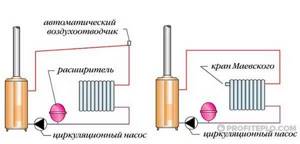
Bleeding air from the heating system using an automatic air vent
To bleed air from a system with forced movement of coolant or a gravity system with bottom wiring, a different principle is used
. Return pipelines are installed at a slope (this simplifies draining liquid from the system), and at the top point of all individual circuits, automatic valves are installed through which air is discharged as it accumulates.
In addition to automatic air vents, the system also uses manual Mayevsky valves. Such air vents are mounted on heating radiators - on the upper pipe on the opposite side of the pipe supplying the heated coolant. To ensure that air enters the valve and does not accumulate in the upper radiator manifold, it is recommended to install the heating device at a slight angle. Air release is performed manually as needed.
How to find an air lock?
Ideally, the system independently copes with airing thanks to automatic valves through which air is released. If you discover that a particular heating device or part of the circuit is not working properly, you need to find the place where the air has accumulated.
Touch the radiator - if its upper part is colder than the lower part, it means that coolant is not flowing there
. To release air, open the Mayevsky valve installed on a steel, aluminum or bimetallic radiator, or the valve valve mounted on cast iron batteries.
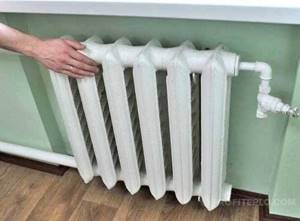
How to determine the air lock in the battery
You can also determine the location of airing by sound - under normal conditions, the coolant moves almost silently, extraneous gurgling and sounds of overflow occur due to an obstacle in the flow
.
Metal pipes and heating appliances are tapped with light blows - in places where air accumulates, the sound is noticeably louder.
Getting rid of the airlock
If there are manual air vents on radiators, there are no problems with how to remove air from the batteries. Using a screwdriver or a standard wrench, the stem of the Mayevsky tap is slightly unscrewed, and a suitable container is placed under the drain hole (a half-liter glass jar is enough). Bleeding air from the heating system using a manual air vent is accompanied by hissing and whistling, then splashes appear, after which the coolant begins to flow in a thin stream. At this stage, the Mayevsky tap should be closed.
To remove an air lock from the heating system if it has accumulated away from the air vent (manual or automatic), proceed as follows
:
- Open the air tap or valve closest to the air bubble.
- They begin to gradually replenish the system with coolant so that the liquid, due to an increase in volume, displaces the air bubble towards the open air vent.
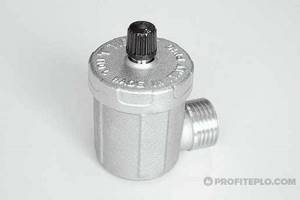
Automatic vent valve with corner connection
What to do in difficult cases when the plug is not removed by adding more coolant? In such a situation, in addition to increasing the amount of coolant, it is necessary to add pressure, heating the liquid to critical temperatures. You should act extremely carefully so as not to be scalded by the splashes that accompany the release of air through the automatic valve.
Bottom Filling with Administrator Access - Air Lock Removal
It’s one thing if the problem can only be solved from your own apartment or by contacting specialists. It’s another matter if you can play the role of a specialist yourself, for example, by gaining access to the basement.
The solution to the problem in this case is as follows:
- Before removing air from the heating system, it must be bypassed, for which the heating valve is first closed and the sewer discharge located underneath is opened;
- After completing the previous steps, the system should be given about 5-10 minutes to release air;
- If the desired effect is not achieved, the system must be turned in the opposite direction;
- After bleeding the air, you need to close the vent and return all valves to their original positions so that the heating circuit continues to function as normal.
Individual risers with which problems have arisen can also be transferred from the basement level. To do this, it is enough to close the valve of one of the connected risers and open the discharge. The probability of successful bleeding of air in this case is quite high, and if one of the risers is used as an idle pipe, then the work will certainly be crowned with success.
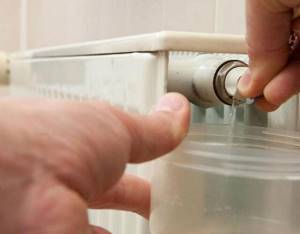
Even if plugs are installed on the risers instead of vents, there are a couple of ways to get rid of an air lock in the heating system:
- The first option is to shut off both risers, reset them, and then replace one of the plugs with a ball valve with a male-female thread. Of course, this option will require the faucet itself - but its cost is low, and such costs are certainly worth it so that the heating system can continue to operate.
- For the second option, you need to close the valves located on the risers, and then unscrew one plug. The riser is put into reset mode, stops, and then the previous operations are repeated in reverse order. This method of bleeding air can only be used when the coolant temperature is below 45 degrees - otherwise the person performing this work may be seriously burned.
How to avoid air locks
The sequence of preventive measures depends on the type of heating system.

Open circuit
This type of system fills itself with hot water. All valves on radiators must be open, allowing unobstructed water access. It is necessary to monitor the pressure and prevent too strong and rapid filling. When filling the free space of the batteries, close the drain valve.
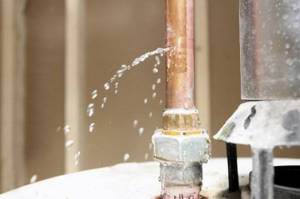
Filling closed systems
The steps to fill this type of system differ from the standards. First of all, the valves are closed. Only the one through which water is poured into the system is left open. Then a pump is connected to ensure stable pressure in the pipes. The air from the batteries is released using taps only after the entire system is filled with water.

You see, if you follow the rules and carry out preventive measures, it is quite possible to minimize the likelihood of air pockets appearing in the heating system, reducing the temperature in the apartment.
Filling the heating circuit with coolant
In order for the heating system to work correctly, it must be flushed and then refilled with water. It is often at this stage that air leaks into the circuit. This occurs due to incorrect actions while filling the contour. In particular, air can be trapped by too fast a flow of water, as mentioned earlier.

The diagram of the expansion tank of an open heating circuit allows you to get an idea of the procedure for filling such a system with coolant after flushing
In addition, correct filling of the circuit also facilitates faster removal of that part of the air masses that are dissolved in the coolant. To begin with, it makes sense to consider an example of filling an open heating system, at the highest point of which the expansion tank is located.
Such a circuit should be filled with coolant starting from its very bottom. For these purposes, a shut-off valve is installed at the bottom of the system, through which tap water is supplied to the system.
A properly designed expansion tank has a special pipe that protects it from overflow.
A hose of such length should be attached to this pipe that its other end is brought out into the area and is located outside the house. Before you start filling the system, you should take care of the heating boiler. It is recommended to disconnect it from the system at this time so that the protective modules of this unit do not work.
Once these preparatory steps have been completed, you can begin filling the contour. The tap at the bottom of the circuit through which tap water flows is opened so that water fills the pipes very slowly.
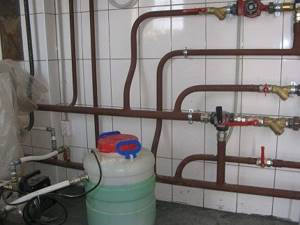
The recommended filling flow rate should be approximately three times less than the maximum possible. This means that the tap should not be turned off completely, but only to one third of the pipe lumen
Slow filling is continued until water flows through the overflow hose leading outside. After this, the water tap should be closed. Now you should go through the entire system and open the Mayevsky valve on each radiator to bleed air.
Then you can reconnect the boiler to the heating system. It is also recommended to open these taps very slowly. While the boiler is filling with coolant, you can hear a hissing sound produced by the air release safety valve.
This is normal. After this, you need to add water to the system again at the same slow pace. The expansion tank should be approximately 60-70% full.
After this, it is necessary to check the operation of the heating system. The boiler is turned on and the heating system is warmed up. Radiators and pipes are then examined to identify areas where heating is missing or insufficient.
Insufficient heating indicates the presence of air in the heating radiators; it must be bled again through the Mayevsky taps. If the procedure for filling the heating circuit with coolant was successful, do not relax.
For at least another week, the operation of the system should be closely monitored, the water level in the expansion tank should be monitored, and the condition of pipes and radiators should be checked. This will allow problems to be quickly resolved.
In a similar way, closed-type systems are filled with coolant. Water should also be supplied to the system at low speed through a special tap.

You can fill a closed-type heating system with working fluid (coolant) on your own. It is important to arm yourself with a pressure gauge for this.
But in such systems, pressure control is an important point. When it reaches a level of two bars, you should turn off the water and bleed air from all radiators through the Mayevsky taps. At the same time, the pressure in the system will begin to decrease. It is necessary to gradually add coolant to the circuit to maintain the pressure at two bar.
It is difficult to perform both of these operations alone. Therefore, it is recommended to complete the filling of a closed contour together with an assistant. While one person bleeds air from the radiators, his partner monitors the pressure level in the system and immediately corrects it. Collaborative work will improve the quality of this type of work and reduce its time.
How to properly bleed air from a battery

In newer battery designs, the valve can be opened with a flathead screwdriver. If there is more than one radiator in your house, make sure that you can open the valve on each one; you must bleed air from all radiators installed in the house. A similar operation must be performed with all batteries in the house, even if there are no problems with them. For prevention, all gases are usually released once a year and after repairs or any other changes to the heating.
Procedure:
- Find a basin or other container to drain the water, then locate the inlet and outlet valves on your radiator and make sure they are open.
- Using the key, turn the valve counterclockwise. At the same time, a characteristic hissing sound should be heard, which means that the air is safely released and replaced with liquid.
- This is where you will need a container; a few drops of water will come out along with the air, and as soon as a steady stream flows from the valve, tighten it back.
Installation of Mayevsky crane
To solve the problem once and for all, you will need to install a Mayevsky crane. For these purposes, it is necessary to purchase a fitting, which is installed in place of the plug and has a thread for screwing in the tap.

Futorka
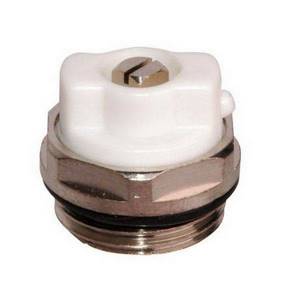
Mayevsky crane
The procedure itself goes as follows:
- Cut off the battery from the general coolant supply using the installed taps. If there are none, then you will need to drain the coolant from the system - in private houses this can be done quite simply, but in apartments you will have to contact the appropriate organization to coordinate such measures.
- Unscrew the plug as described in the first section of the article.
- Clean the thread from dirt and ensure its integrity. If the grooves are “licked”, trim the thread using a tap.
- As a sealant, wrap a small amount of flax or fum tape around the threads.
- Screw in the fitting, then install the Mayevsky tap on the cast iron battery.
- Fill the system with water and make sure there are no leaks.
Video on installing the Mayevsky crane:
Using the valve to bleed air is very simple; just remove the protective cap and use a screwdriver to unscrew the valve until a characteristic whistle appears. If water immediately flows from the outlet, it means that the radiator is completely filled with coolant. There are several reasons why the battery remains cold after bleeding.
By acting in accordance with the recommendations presented, you will be able to bleed air from the cast iron battery. Unscrewing the plug is suitable if the radiator is relatively new and the connections have not yet had time to “stick” to each other. Drilling a small hole is applicable even for old batteries that cannot be disassembled.
Types of air vents and their installation locations
- Mayevsky's manual tap.
Also called a needle radiator valve, it is distinguished by its simplicity and durability, and is made of brass. The design involves a body and a conical screw. All parts fit tightly against each other and reliably hold water in the battery. When opened, air is released from a small hole on the side. The Mayevsky tap comes in different designs and, depending on this, can open differently.
Installation of such a crane does not require special professionalism. The main thing is to choose the right size faucet. Before installation, you need to drain the water from your battery, and then unscrew the plug in the radiator cap. For greater reliability, you can wrap FUM tape around the thread.
The product can be purchased at a price of 30 rubles.
- Automatic air vent.
This device automatically removes all gases accumulated in the pipeline, and is therefore undoubtedly more convenient than the Mayevsky tap. Made from bronze and stainless steel. It can be installed with a shut-off valve, which is needed to easily replace the air vent.
An automatic air vent is installed in the highest places of the heating system, since gas is lighter than liquid and rises to the top. Experts recommend installing a diverter behind the boiler, on the collectors and at the highest points where the pipes pass.
Prices for such equipment start at 300 rubles.
- Air separator.
The operating principle of this device is based on separating gas from liquid and removes all microbubbles and oxygen dissolved in water from the system. The design uses special PALL rings, and all microscopic air bubbles are caught by their surface. In addition to catching bubbles, separators also catch dirt circulating in the system.
A separator is installed immediately after the boiler, since most of the oxygen is released from the water when heated and is best removed immediately.
Such equipment can be called advanced and the prices for it are correspondingly higher - from 10 thousand rubles.
- Multi-stage system.
It is considered the most effective method of removing air accumulated in pipes and radiators. It consists in combining several types of devices in one circuit. Typically looks like this:
- Mayevsky's battery-powered crane.
- Automatic air vent next to the boiler.
- Air vents on the manifolds.
- Separator after the boiler.
The best option usually costs more than the others, and our case is no exception. The exact price is determined from a specific scheme.
Automatic air vent
Float, fully automated. Several installation options. On the side of the radiator horizontally or vertically. Without human intervention, it reacts to the total amount of water in the heating system and, when air accumulations form, automatically releases it through the valve. If the water level in the radiator drops, the float automatically opens the valve, which releases the plug. This device is very convenient and will help you eliminate emergency situations if, for example, you are away from home for a long time.

It has one disadvantage - it is sensitive to the chemical elements of water in the coolant. Due to the impurities contained in the water, it quickly becomes unusable. Breakage can be prevented by installing water filter elements and preventive inspection and replacement of the seal ring.

The installation of this automated system is suitable for use in the private sector; it does not require restarting the system or refilling the batteries. Proper use and preventative measures will increase the service life.
Signs and dangers of air locks
Such air congestion significantly reduces the heating efficiency of heating devices, which negatively affects the overall temperature in the apartment.

The most obvious sign of a traffic jam is gurgling, knocking, or babbling in the pipes when water is poured into the heating pipes. For owners of private houses with heating boilers, if you hear such sounds, bleed the air from the radiators, otherwise this will lead to damage to the boiler. If the heating of the battery surface is uneven, lightly tap the battery surface with a metal object. In those places where air accumulates, the sound of the impact will be loud and resonant.

Prolonged contact between the battery metal and the air inside leads to corrosive deposits, which will then cause the device to fail. These are the main reasons why it is advised to bleed the air from the battery as quickly as possible.
Safety precautions and preventive measures
To avoid injuries and other problems, it is necessary to follow a number of rules when bleeding air:
- You cannot unscrew the rod from the air valve - the pressure of the heated coolant
will not allow you to screw it back in; - The body of the tap should also not be turned out - it is quite easy to damage the threads, and it is difficult to eliminate the results of flooding of the apartment;
- Radiator caps cannot be unscrewed even partially - they cannot be returned later, and boiling water pouring out of heating appliances will bring a lot of negative emotions (read also: “Which radiator caps are best to use when installing heating radiators”).
When living on the top floor or in your own home, you can take protective measures that will allow you to subsequently not think about how to bleed air from an aluminum heating device:
- In an independent heating system, it will be enough to install heating devices using a bottom connection so that the air entering the device for heating the room does not affect its performance;
- At the top point of the riser or individual heating, you can install automated air valves, which on their own will release all the air from the radiators.
Conclusion
This article answers in detail the question about how to properly bleed air from heating systems. Such a task has a number of invisible aspects and difficulties, so if you lack decisiveness in your abilities, it is best to leave it to specialized professionals or the local housing authority.
Heating air vent
Design, principle of operation of the air vent
But in addition to radiators, situations often arise when it is necessary to expel an air lock from the heating system in the pipes. To do this, it is necessary to install air vents in certain sections of the pipeline. Their design is in many ways similar to the Mayevsky automatic cranes described. However, there are significant differences - they are designed for the largest volume of air released and are installed not horizontally, but vertically.
In order to remove the resulting air lock from the heating system, you first need to install air vents in the right places:
- At the highest point of the highway. For an open system, this is only possible if a sealed expansion tank is installed on the return pipe;
- In collector heating - on each comb;
- For tee wiring - before each branching node of the main line.
After installation, it is necessary to correctly set the pressure value at which the air vent will operate. To remove an air lock from the heating system, coolant is pumped into the pipes until the air vent on the return line operates.
When removing an air lock in an autonomous heating system, you need to reduce the temperature of the coolant to a minimum. This will reduce the volume of water and will help resolve the problem more effectively.
In combination with the functional qualities of Mayevsky taps, this makes it possible to effectively break through any plug in the heating
It is important that the response parameters of the devices do not exceed the critical pressure value. Otherwise, the security of the system may be at risk
The video shows an example of venting a heating radiator:
Causes of airiness
Air plugs form in heating systems for a number of reasons:
- As a result of replacing radiators in the apartment. It is most often produced in the summer on the eve of the new heating season. After the pressure testing is completed, the risers are filled with water, and the bleeding of air from the heating system is postponed until the fall.
- After carrying out an inspection of the shut-off valves on the risers, which are needed to drain the circuit.
- As a result of checking the shut-off valves in the elevator unit. The circuit should be reset completely.
- From coolant leaks through battery intersections, threaded connections, fistulas formed in pipes, etc. If the valves in the elevator are in good condition and closed, the pressure in the circuit gradually begins to drop. In this case, you need to slightly open the Mayevsky tap or the flusher located on the top floor. As a result, the vacuum that arises at the top of the circuit sucks in air.
Types of air vents
The air vents themselves are divided into automatic and manual. In the case of tame ones, they are also called Mayevsky. They have small dimensions and are placed on the end parts of the heating system. The tap is adjusted using a key, while others do it manually. Of course, small size affects performance. Mayevsky's crane is suitable only for local removal of air jams.
Automatic options work without human intervention. They can be installed horizontally or vertically. The performance is quite high, but there is also a significant drawback - increased sensitivity to pollution. In this regard, their installation is carried out immediately with filters for reliability.
Automatic air vents are installed according to a certain pattern: along a line of pipes at several different points. It turns out that air is released separately from each group. This multi-stage deaeration system is called the most effective. If the pipes are laid correctly, there will be no problems with air removal.
Humidifiers
During the heating period, it is recommended to maintain the indoor humidity necessary for normal living. For this you need humidifiers.
You can make them yourself. There is a lot of information on the Internet to implement this idea. Otherwise, radiator-mounted air humidifiers can be purchased and installed yourself. You can find out how to bleed air from the battery by following this link.
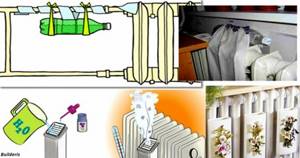
Homemade and industrial humidifiers. Read about long-burning wood stove on our website.
Prices for automatic air vents
automatic air vent
Mayevsky's air bleeder valve: how to bleed air from the heating system
Air vents are manual and automatic. Manual devices for air removal, or Mayevsky’s air separator, appear to be small in size. They are usually installed on the end of the battery. The Mayevsky vent valve is adjusted using a regular wrench, a screwdriver, and some even manually.
The second type of devices capable of draining or blowing air are automatic devices that operate without human intervention.
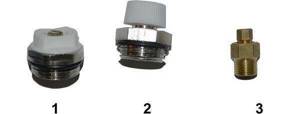
Features of air exhaust devices:
- They have high efficiency during operation, however, they are very sensitive to contaminated water;
- They are usually mounted together with filters;
- It is customary to install an air vent in closed heating systems using a gas boiler at different points;
- Air is released from each device separately;
- An effective multi-stage air exhaust system that pushes through plugs well is considered the most effective.
If the pipes are laid and installed correctly, pushing air through this device will be simple and not a problem. According to customers of the Tovago website, Mayevsky’s air blower crane is very popular today.
Closed system of a private house - how to remove an airlock
An automatic air vent is placed in the circuit through which the coolant is forced to move, operating at excess pressure. It is an element of the safety group of the heating unit and is mounted at the outlet of the heat exchanger.

Some boiler models have their own safety group installed inside the housing. All batteries located above the bottling points are equipped with Mayevsky taps or air vents. The latter are certainly needed when connecting devices diagonally or sideways. In the case of a lower two-way connection, the operation of an air-filled radiator is possible. The following method is used to bleed air from the heating system: it is forced into the upper collector, and the coolant is released through the lower one. The battery sections are heated in height due to the thermal conductivity of the metal.
Where does air come from in the system?
The reasons for the formation of an air lock can be either natural or related to improper system design and poor-quality installation.
Naturally occurring reasons:
- when the coolant is heated, air dissolved in the liquid is released, it rises to the top and forms a plug;
- gas bubbles appear during the interaction of a hot coolant with certain types of metals (in particular, aluminum);
- due to evaporation, the liquid level in the open expansion tank decreases below a critical value;
- the air does not have time to completely escape from the pipes and batteries when the complex configuration of the system is filled too quickly with water.
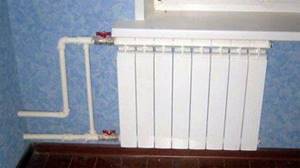
. In addition to natural reasons, the appearance of air locks also leads to:
- incorrect layout of horizontal pipes and installation of radiators;
- pressure drops in the feed water supply;
- poorly sealed connections;
- deterioration of old pipelines;
- expansion tank malfunction.
When during operation of the heating system it turns out that it was originally designed incorrectly, it will have to be redone. But in order to urgently restore the heat supply, you need to decide how to bleed air from the heating system.
Open heating system in a private house
Such a system operates when the pressure and height of the water column formed by the lower and upper points of the heating circuit correspond. In this case, the bottling is arranged at a constant slope, and an open expansion device is located at its highest point.
It combines a number of functions:
- expansion tank, which compensates for the increase in liquid volume when heated;
- a safety valve that serves to relieve excess pressure in the event of water boiling in the heat exchanger of the heating unit;
- an air vent, thanks to which the problem of how to expel air from the heating system is solved - it must be forced into the upper part of the circuit, or rather into the expansion tank, from where it is sent into the atmosphere.

Why does the heating system get airy?

Most often, when traffic jams occur, it turns out that a small leak has formed somewhere. It may not be visible to the naked eye, because a small amount of water may have time to dry on the surface of the pipe. A more effective way to detect leaks is to inspect the system with a thermal imager. Air inevitably enters during the coolant filling stage
After the system has been filled, it is important to bleed the air several times. Traffic jams could have occurred during repair work. Even if the system has not been repaired, over time oxygen is released from the water, which accumulates in the upper points of the pipeline. A leak can occur where it is least expected - in air vents; modern automatic models operating in low-quality coolant are especially susceptible to this.
Reasons for airing the system
There are several fairly common reasons that provoke the appearance of an air lock inside heating structures:
- depressurization that occurred during scheduled maintenance or repair work;
- improper flushing or pressure testing of the system followed by filling the water circuit with standard coolant;
- local violation of the integrity of pipelines and radiator batteries under negative external influences or as a result of maintenance and operating errors;
- in private households - the absence of a sufficient pipe slope and expansion tank in the installed system;
- reduced pressure level in the water supply system, filling the resulting voids with air;
- faulty condition of air intake elements;
- connection to the heating structure of a “warm floor” system with pipes of different heights;
- air suction through leaky seam joints and joint areas;
- low quality coolant, oversaturation with gases;
- replenishing the volume of thermal fluid by adding cold tap water.
One of the most common problems is the presence of errors and errors at the stage of creating design documentation or installing pipework.
Bottom line
To summarize, we can say that the problem of airing the system is quite urgent. It can occur in urban high-rise buildings and in private homes. There can be many factors behind the formation of excess air. It is very important to establish the true cause and know how to bleed air from the heating radiator correctly so that similar situations do not occur in the future.
The installation of special air vents also plays an important role in the proper and efficient operation of radiators. By installing such a device, the owner of a house or apartment will be able to forget about the problem of air locks, save time and money, and also extend the service life of the entire heating system.
Air in the battery: what is it and how to determine it
What is airiness in a heating battery? This concept refers to the accumulation of air, most often in the upper part of the heating radiator. This situation becomes a problem and quite common for those who live in multi-storey buildings on one of the top floors. There may be several reasons for such a problem:
- Carrying out repair work on the site/on adjacent floors. If work was done on heating pipes in a residential area, there is a high probability of a small air flow entering the system.
- A coolant leak has occurred in some area (which means an immediate check of the system is required to eliminate the leak).
- Features of the underfloor heating system. The problem of airiness in the system is indeed a common picture when there is a heated floor system, especially if it has a complex layout and many branches.
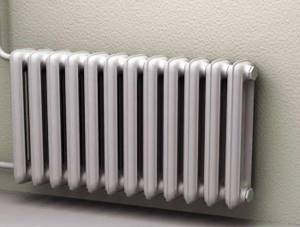
Cast iron battery
- High-temperature water contains air, and the more often the coolant is renewed in the system, the higher the likelihood of a problem occurring.
- If the appearance of an air “plug” coincides in time with the start-up of the common heating main, we can say with a greater degree of probability that it was the start-up of the system that caused the airiness.
Determining the presence of an air lock is quite simple. For example, if the temperature of the water in the battery has dropped sharply or the battery has become only partially cold, it may even begin to gurgle - all these are signs of airiness.
What can an airy radiator cause?
If there is an air lock in the radiator, it begins to heat worse. The larger the air volume inside the sections, the worse they heat.
For aluminum radiators, air does not pose a particular danger, unlike steel and bimetallic ones with a steel interior. Metal corrosion occurs at the point of contact between air and water, which is why it is so important to identify and remove air pollution in a timely manner.
If air appears in the system, it means it can accumulate in the pump, pipelines, heating boiler, etc. this leads to reduced service life.
When air accumulates in the pump, it begins to work with increased power, overheat and wear out heavily. If air gets into the boiler, the water in the heating system will boil, which can lead to a break.
We hope that the article was useful to you and we answered the question of how to get rid of air in a heating radiator. Don't forget to share the post on social networks
Mayevsky crane
Design of the Mayevsky crane
It is designed to eliminate air lock in the heating battery. Despite its small size, the Mayevsky faucet helps to effectively remove accumulated steam not only in radiators, but also in pipes.
Structurally, it is a needle valve enclosed in a metal housing. How to remove an air lock from a heating system using it? First you need to decide on the device model.
Manual taps
After installation in the upper radiator pipe, air is released after turning the union nut on the tap. Removing an air lock from the heating system using a Mayevsky manual tap is carried out according to the following scheme:
- Filling the system with coolant. The taps on the radiators are closed;
- When the maximum level is reached, the water supply stops;
- Having set the required gap of the needle limiter in the devices, the taps are opened;
- At the same time, the coolant supply is restored.
Water is added to the system until liquid begins to flow from all Mayevsky taps. Be sure to check that there is no air flow. This method is effective for removing air locks in heating radiators when starting the system for the first time, before the season, or when airiness appears during operation.
Manual models will effectively eliminate air lock in the radiator for both autonomous and central heating. The main thing is to choose the right mounting thread. In most cases it is 1/2", but there are models with a non-standard size of 3/4".
Automatic taps
Mayevsky automatic crane
Unlike the model described above, in their design, a seat with a certain surface area is installed on the end of the needle valve. In combination with a return spring, the degree of pressure of which determines the critical pressure value at which the valve opens. A detailed device is designed to automatically break through a heating plug when a critical temperature value and, as a result, pressure is exceeded.
However, before installation you should familiarize yourself with the specifics of this model:
- To prevent water from getting onto the floor, the structure must have a pipe to drain excess water into the sewer;
- If it sits for a long time, the valve seat may become covered with limescale, which will make it difficult to open. Therefore, it is recommended to open the tap manually once every 2-3 months. The steps of the procedure must be done before starting the heating for the first time;
- The set maximum opening pressure should not exceed the critical pressure of the entire system. In order to remove an air lock from the heating in automatic mode, the pressure value on the tap should be 5-10% less than the maximum.
What is better to install: an automatic or manual Mayevsky crane? If the operation of the system does not involve sudden pressure surges, manual models can be installed on the radiators. For autonomous heating, preference is given to automatic ones.
It is best to choose models made of brass. During the expulsion of an air lock from the heating, they can withstand not only a critical pressure value, but also a temperature. The steel body is subject to destruction and rusting.
How long do you need to bleed the batteries?
The duration of the procedure is determined individually. It all depends on the scheme, type of heating, degree of airing. Usually the process is considered complete when the air stops hissing from the tap and the water flows in a steady stream.
The deaeration process is considered complete when water flows steadily from the tap.
To confidently remove the air lock in the heating battery, drain 3 buckets of water through the tap. With this amount of coolant, all the air is guaranteed to escape.

